"SWITCHBARREL FAVORITE"
32 WCF (32-20) and 218 Bee
This project took several years to complete, from turning the barrels through engraving the action to finding the correct Tong Tool and dies, scoping the Bee barrel, to finally making a custom ash and leather case for the entire ensemble. The project was to be a birthday present for my son who was then 10 years old. He is now seventeen and this will be a high school graduation present.
This project took so long I forget who did the lathe work. At that time I did not have a lathe. Larry Peters in Odessa WA did the engraving work. I did the metal finishing and stocking, checkering, etc. The semi-finished English Walnut stock I got from Wenigs. I made the case from ash lumber felled on our property in Canby OR.
Many say the 1915 Stevens Favorite is not an adequate action for centerfire conversions, and at least one claims to have blown up an action after converting it to the mild 32 S&W pistol cartridge. I have done three of them now including a 357/256 Win Mag, a 22lr/32-20, and this 218 Bee/32-20. Actually this is a 3 barrel set as I have an extra rimfire breech block and 22 mag barrel for the gun that is not shown. I have also done two 22 mag conversions that were not switchbarrels. Well actually one was, I have a second 22lr barrel for it and both work fine with the same receiver. But there isn't much point in this 22lr/22mag switchbarrel so I used the 22lr barrel to make another rifle utilizing a spare receiver I had. The action pins and screws are the weak point of the action, particularly the lever screw. I have overcome this by using modern hardened dowel pins, slightly oversized to allow for wear to the original breech blocks and levers; and oversized lever screws made from drill rod suitably hardened and tempered. My first conversion employed a grade 8 bolt for the lever screw. I turned the head down on a grinder and slotted it with a slot file, not having a lathe at that time. I retapped the receiver for the new slightly oversized thread. Of course, the object of the exercise is not to push the limits, so ammo should be mild reloads not factory stuff and certainly not full pressure reloads. However, having said all that, if you don't know what you are doing, don't even think about using the Favorite actions for any such conversions; and even if you do know what you are doing, proceed at your peril.
For this conversion I moved the firing pin to a centerfire configuration. This takes some doing, you need a proper mill to bore out and bush the breech block and then redrill the firing pin cavity. You can get away with welding up the firing pin hole, drilling a new hole, and using an eccentric firing pin, but only if you need to move the pin a small distance (eg from a 22lr to a centerfire, or a 25 rimfire to a 22 rimfire). In other cases (eg when doing a hybrid with one rimfire barrel and one centerfire barrel) I have left the breech block and firing pin alone and turned the centerfire barrel with an eccentric shank to move the primer to the pin rather than vice versa. On the first conversion, we threaded the barrels into the receiver like a Stevens 44, but on the later ones we just used the standard barrel screw making sure the fit was good and the pin was properly hardened. If you thread the barrel, you have to remove the scope to remove the barrel! So a slip-in barrel is easier to deal with.
If there is any way to explain how we get away with this, it lies in the fact that with relatively straight walled cases, the case grips the chamber walls relieving much of the "Back thrust" on the breech block and the associated pins. However, there is some increase in force as I did succeed in bending the lever screw on my first attempt after a few shots. This was remedied by the aforementioned grade 8 (aircraft grade) screw. To further reduce back pressure, I scuffed the chamber with 180 grit and I clean the oil out of it before firing.
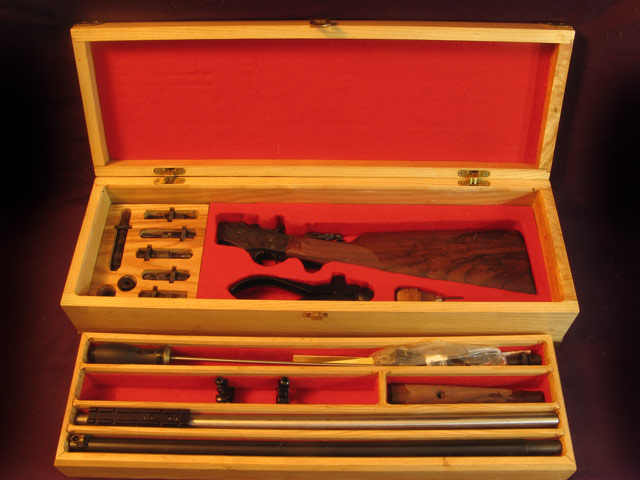 The completed ensemble in a custom ash and leather two tier case. The ash was cut from a blowdown on my property in Oregon, cut with a bandsaw in about 1997, and dried in my barn. I used flush "Soss" hinges and would not use any other. I make the box first and then cut the lid loose. The bottom and top, and the tray bottom are light ply to keep the weight down. Two tiers makes for a very compact case, and besides it's sexy. The scope is not shown in the photo, but I used a Redfield 3/4" 4x for the 218 Bee barrel. It was not easy to find 3/4" rings that fit on a normal Weaver rail. A 1" scope is too bulky on this scaled down rifle in my opinion. The other option is to use a 7/8" scope in Redfield type rings, or in Weaver rings if you put a tip-off rail on the barrel.
The completed ensemble in a custom ash and leather two tier case. The ash was cut from a blowdown on my property in Oregon, cut with a bandsaw in about 1997, and dried in my barn. I used flush "Soss" hinges and would not use any other. I make the box first and then cut the lid loose. The bottom and top, and the tray bottom are light ply to keep the weight down. Two tiers makes for a very compact case, and besides it's sexy. The scope is not shown in the photo, but I used a Redfield 3/4" 4x for the 218 Bee barrel. It was not easy to find 3/4" rings that fit on a normal Weaver rail. A 1" scope is too bulky on this scaled down rifle in my opinion. The other option is to use a 7/8" scope in Redfield type rings, or in Weaver rings if you put a tip-off rail on the barrel. |
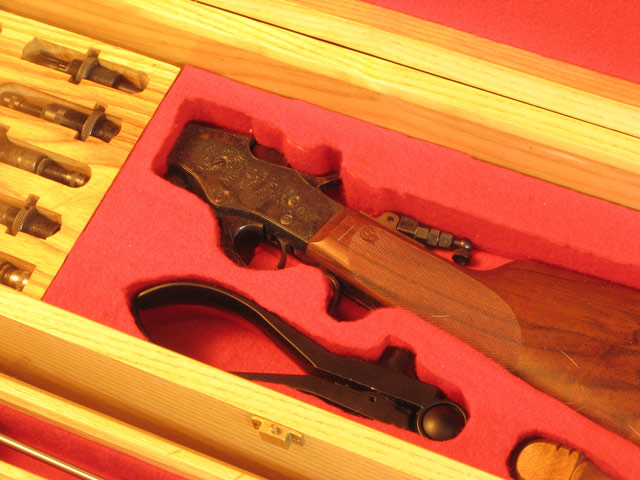 Everything except the long bits and the scope fits in the bottom tray. I made a custom block for the two die sets. Since the finish on the dies is not important, this saves having to line the die cavities with felt. I used cedar lined with felt for the rest as it's very light. The two calibers use common decapping and priming dies so 8 dies were necessary, not 10. In addition, in the top tray there is a loose 224 cal sizing die for cast bullets. I could not find a 32 cal sizing die but when I do I will add it. By keeping the case short, I was able to use a single mechanical latch that I purchased from a woodworking store along with the "Soss" type hinges. I decided not to make the case lockable as the key inevitably gets lost. And I passed on a handle as it's hard to find a handle that looks right, and besides the case is a little too heavy for one handle. I thought about putting trunk-style handles on either end and may still do so. I did this on another similar case and it works fine. The tang sight is a custom reproduction unit by Varner, intended for use with the 32-20 barrel. I could not find an original Marbles or Lyman sight for reasonable money, and since this is a modern reincarnation of a vintage rifle, I did not see the need to spend extra money for a period tang sight.
Everything except the long bits and the scope fits in the bottom tray. I made a custom block for the two die sets. Since the finish on the dies is not important, this saves having to line the die cavities with felt. I used cedar lined with felt for the rest as it's very light. The two calibers use common decapping and priming dies so 8 dies were necessary, not 10. In addition, in the top tray there is a loose 224 cal sizing die for cast bullets. I could not find a 32 cal sizing die but when I do I will add it. By keeping the case short, I was able to use a single mechanical latch that I purchased from a woodworking store along with the "Soss" type hinges. I decided not to make the case lockable as the key inevitably gets lost. And I passed on a handle as it's hard to find a handle that looks right, and besides the case is a little too heavy for one handle. I thought about putting trunk-style handles on either end and may still do so. I did this on another similar case and it works fine. The tang sight is a custom reproduction unit by Varner, intended for use with the 32-20 barrel. I could not find an original Marbles or Lyman sight for reasonable money, and since this is a modern reincarnation of a vintage rifle, I did not see the need to spend extra money for a period tang sight.
|
| |
|
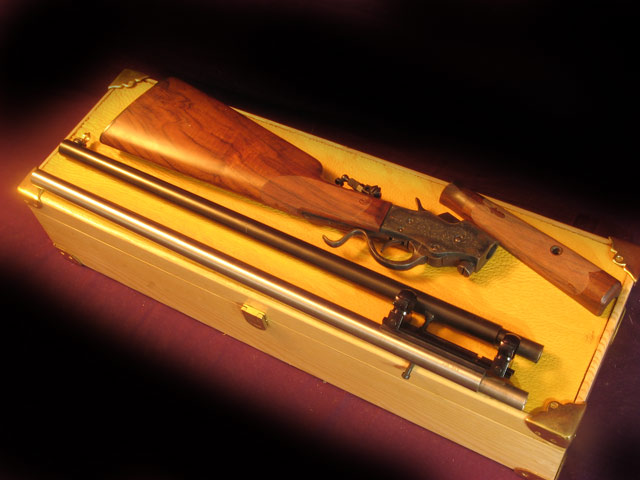 By using the same barrel contour, I was able to utilize the same forend for both. Note the forend tip on the barrel, it's ebony. That took some doing. The brass case corners came from India, I use them to repair English shotgun cases. The length of the case was determined by the barrel length. The 32-20 barrel came from Numrich as a new blank in the white. It was rust blued and a reproduction "Beech" style brass front sight dovetailed in by hand. The sight came from Dixie Gun Works if memory serves. The Bee barrel is stainless, not by design. I discovered that when I tried to rust blue it! The barrel was a take-off from a 22-250. I put a Weaver rail from a Contender on it, before I realized that all Weaver rings are 1" or 30mm. I did find some custom 3/4" Weaver rings on eBay that worked fine. I had to make custom "slimline" release levers for the rings to get the scope and rings to fit in the case.
By using the same barrel contour, I was able to utilize the same forend for both. Note the forend tip on the barrel, it's ebony. That took some doing. The brass case corners came from India, I use them to repair English shotgun cases. The length of the case was determined by the barrel length. The 32-20 barrel came from Numrich as a new blank in the white. It was rust blued and a reproduction "Beech" style brass front sight dovetailed in by hand. The sight came from Dixie Gun Works if memory serves. The Bee barrel is stainless, not by design. I discovered that when I tried to rust blue it! The barrel was a take-off from a 22-250. I put a Weaver rail from a Contender on it, before I realized that all Weaver rings are 1" or 30mm. I did find some custom 3/4" Weaver rings on eBay that worked fine. I had to make custom "slimline" release levers for the rings to get the scope and rings to fit in the case.
|
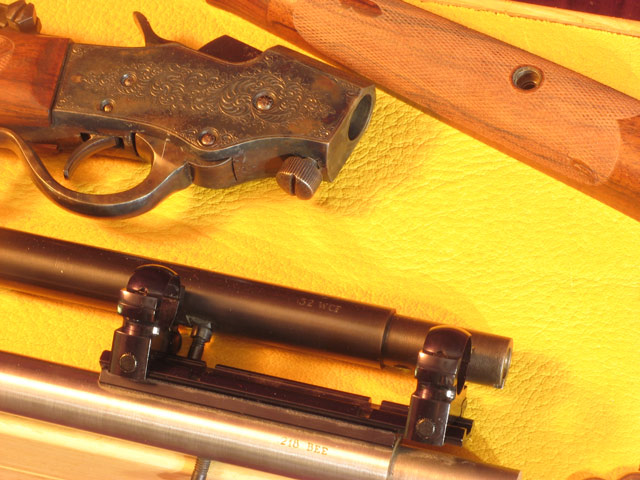 For reasons I don't recall, I used a different method to thread the barrels for the forend screw. On the blued barrel, I dovetailed in a Contender threaded nut. The other barrel was drilled and tapped normally. Each barrel has its own screw. The same forend fits both barrels. The "antiqued" finish on the action was accomplished by heat treating the action in air after case coloring and before coating. I used clear spray-on finish back then. I now use clear Cerakote over case colored parts, it is much more durable. The scope rail is for a Contender. The rings are custom scaled down Weaver rings (nobody makes a 3/4" standard Weaver ring .. the 3/4' and 7/8' rings are all made for 22 rails.) In retrospect, it would have been easier to use a standard 3/8" tip off rail.
For reasons I don't recall, I used a different method to thread the barrels for the forend screw. On the blued barrel, I dovetailed in a Contender threaded nut. The other barrel was drilled and tapped normally. Each barrel has its own screw. The same forend fits both barrels. The "antiqued" finish on the action was accomplished by heat treating the action in air after case coloring and before coating. I used clear spray-on finish back then. I now use clear Cerakote over case colored parts, it is much more durable. The scope rail is for a Contender. The rings are custom scaled down Weaver rings (nobody makes a 3/4" standard Weaver ring .. the 3/4' and 7/8' rings are all made for 22 rails.) In retrospect, it would have been easier to use a standard 3/8" tip off rail.
|
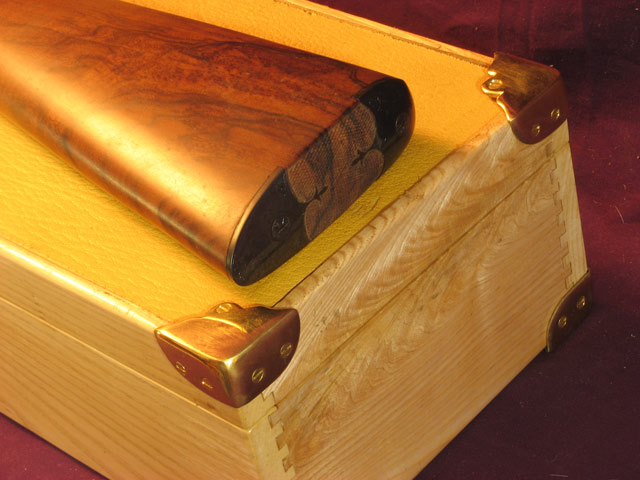 The heel and toe plates came from Galazans. It took a long time to inlet them. Bob Evans, who later taught me to engrave, engraved them for me. Note the miniature dovetailing of the box corners. I procured a special jig for the job. Also the checkering on the butt.
The heel and toe plates came from Galazans. It took a long time to inlet them. Bob Evans, who later taught me to engrave, engraved them for me. Note the miniature dovetailing of the box corners. I procured a special jig for the job. Also the checkering on the butt.
| 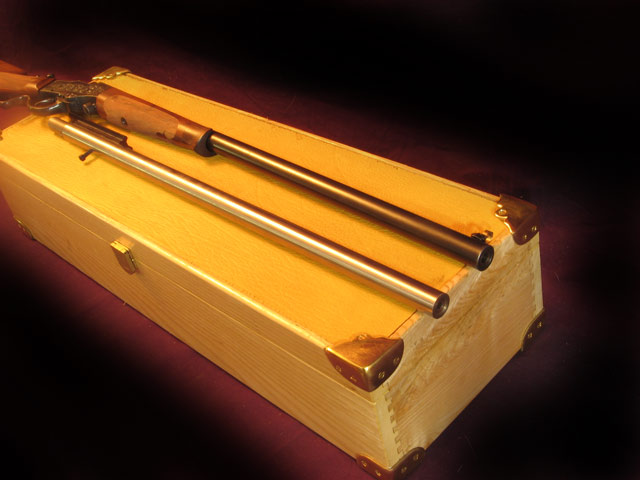 The business ends of the barrels. They have matching recessed crowns. I think they are cut .800" all the way from breech to muzzle, this was done so I could use the Contender scope rail. That contour gives a nice heft to the gun. Now if only Varner would offer a centerfire version of their new Favorite, we would not need to go to all this trouble to come up with a scaled down single shot rifle!
The business ends of the barrels. They have matching recessed crowns. I think they are cut .800" all the way from breech to muzzle, this was done so I could use the Contender scope rail. That contour gives a nice heft to the gun. Now if only Varner would offer a centerfire version of their new Favorite, we would not need to go to all this trouble to come up with a scaled down single shot rifle!
|
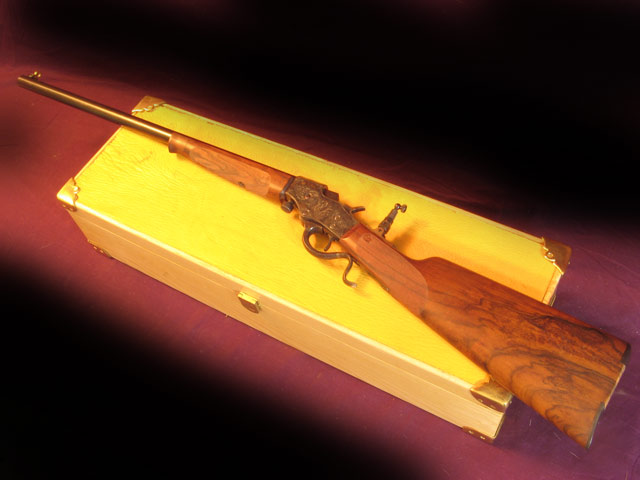 I can look at this picture all day long. A lot of work went into a compact package. It came out better than I hoped. I am glad I spent the extra money for the English Walnut stock, it really makes the rifle.
I can look at this picture all day long. A lot of work went into a compact package. It came out better than I hoped. I am glad I spent the extra money for the English Walnut stock, it really makes the rifle.
| 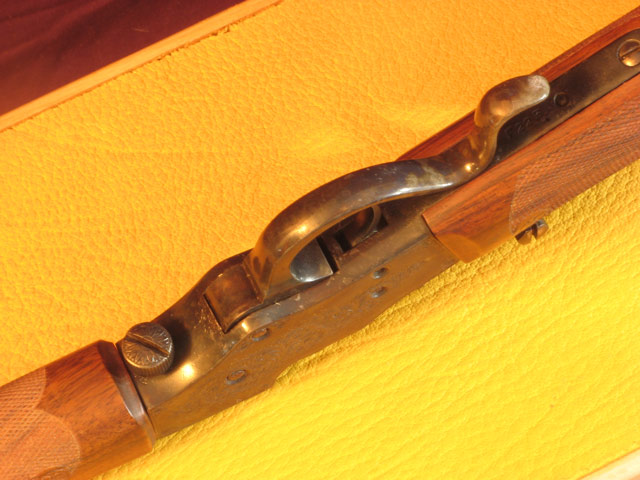 Underneath the barrel screw is a special inscription."For Evan from Dad" When he was a kid around 6 years old, he presented me with a rather impressive Lego fighter jet he put together and proudly stated "This is my best work". Back at you, Son.
Underneath the barrel screw is a special inscription."For Evan from Dad" When he was a kid around 6 years old, he presented me with a rather impressive Lego fighter jet he put together and proudly stated "This is my best work". Back at you, Son.
|
|
Back to Varmint Hunter HQ